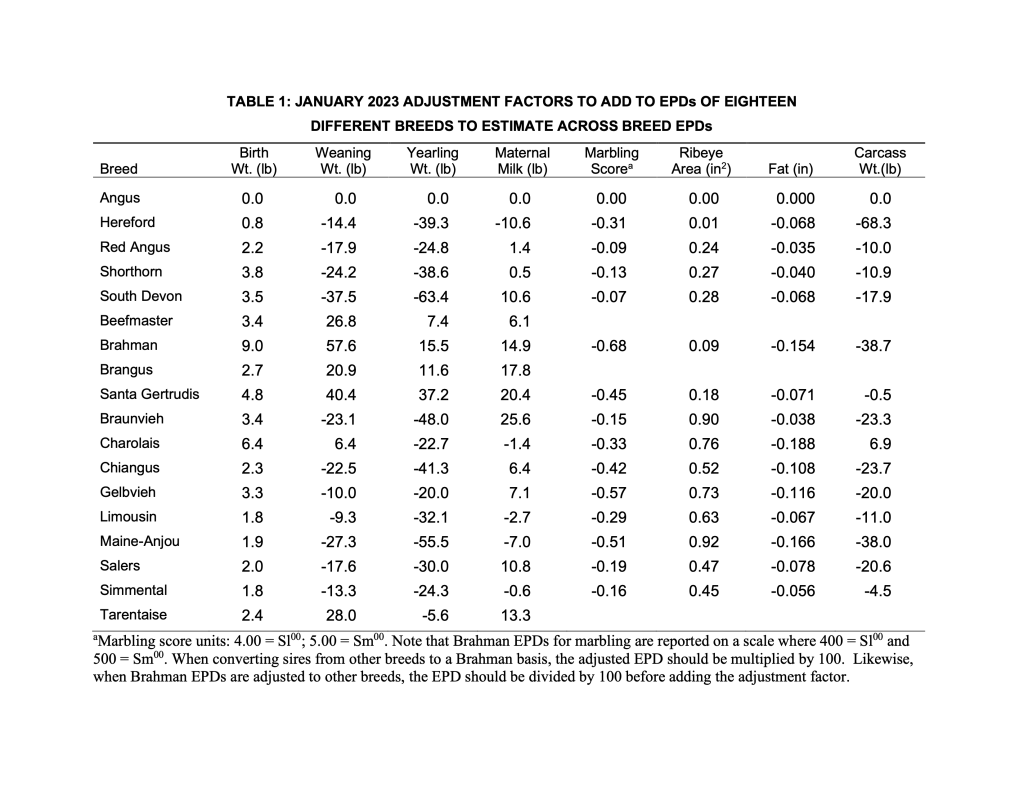by Larry Kuehn and Mark Thallman
Across-Breed EPD (ABEPD) Adjustment Factors: National Cattle Evaluation (NCE), and the resulting Expected Progeny Differences (EPDs), have resulted in substantial genetic change since their inception in the 1970s. However, EPDs are generally only comparable within breed because of differences in the genetic base. Since 1993, the U.S. Meat Animal Research Center (USMARC) has produced a table of factors to adjust the EPDs of cattle so that the merit of individuals can be compared across breeds. Adjustment factors for carcass traits have been calculated since 2009 and carcass weight was added in 2015; to be included, breeds must have carcass data in the U.S. Meat Animal Research Center (USMARC) database and report their carcass EPDs on an actual carcass basis using an age-adjusted endpoint.
Bulls of different breeds can be compared on the same EPD scale by adding the appropriate adjustment factor to the EPDs produced in the most recent genetic evaluations for each of the eighteen breeds. Normally, the EPDs of animals from different breeds cannot be compared because many breed associations compute their EPDs in separate analyses and each breed has a different base point. The across-breed adjustment factors allow producers to compare the EPDs for animals from different breeds for these traits; these factors reflect both the current breed difference (for animals born in 2021) and differences in the breed base point. The AB- EPDs are most useful to commercial producers purchasing bulls of more than one breed to use in cross-breeding programs. For example, in terminal cross-breeding systems, AB-EPDs can identify bulls in different breeds with high growth potential or favorable carcass characteristics.
The factors are derived by estimating breed differences from the USMARC germplasm evaluation program and adjusting these differences for the EPDs of the sires that were sampled in the system. The traits for which factors are estimated are birth weight, weaning weight, yearling weight, maternal weaning weight (milk), marbling score, ribeye area, backfat depth (fat), and carcass weight (Table 1). These factors adjust the EPDs to an Angus base (chosen arbitrarily).

As an example, suppose a Red Angus bull has a yearling weight EPD of + 90.0 lb and a Hereford bull has a yearling weight EPD of + 92.0 lb. The across-breed adjustment factors for yearling weight (see Table 1) are -24.8 lb for Red Angus and -39.3 lb for Hereford. The AB-EPD is 90.0 lb – 24.8 lb = 65.2 lb for the Red Angus bull and 92.0 lb – 39.3 = 52.7 lb for the Hereford bull. The expected weaning weight difference of offspring when both are mated to cows of another breed (e.g., Braunvieh) would be 65.2 lb – 52.7 lb = 12.5 lb.
Brahman EPDs for marbling score are reported on a different scale than the other breeds with marbling score EPDs. For Brahman 400 = Sl00 and 500 = Sm00 whereas for the other breeds, 4.00 = Sl00 and 5.00 = Sm00 meaning the Brahman EPDs are reported on a scale that is 100 times higher. As a result, EPDs from other breeds need to be multiplied by 100 after being adjusted to Brahman, and Brahman EPDs need to be divided by 100 prior to applying the adjustment factors. For instance, to adjust a Simmental bull with a marbling score EPD of 0.15 to compare to Brahman bulls using the factors from Table 1, add the Simmental factor, subtract the Brahman factor, and then multiply by 100: ( 0.15 + ( -0.16 ) – ( -0.68 ) ) * 100 = 67. Similarly, to adjust a Brahman bull with a marbling score EPD of 40 in order to compare to Simmental bulls using the same factors, first divide by 100, then add the Brahman factor, and subtract the Simmental factor: 40 / 100 + ( -0.68 ) – ( -0.16 ) = -0.12.
It is important to note that the table factors (Table 1) do not represent a direct comparison among the different breeds because of base differences between the breeds. They should only be used to compare the EPDs (AB-EPDs) of animals in different breeds. To reduce confusion, breed of sire means (i.e., one half of full breed effect; breed of sire means predict differences when bulls from two different breeds are mated to cows of a third, unrelated breed) for animals born in 2021 under conditions similar to USMARC are presented in Table 2.

The adjustment factors in Table 1 were updated using EPDs from the most recent national cattle evaluations conducted by each of the eighteen breed associations (current as of January 2023). The breed differences used to calculate the factors are based on comparisons of progeny of sires from each of these breeds in the Germplasm Evaluation Program at USMARC in Clay Center, Nebraska. These analyses were conducted by USMARC geneticists Larry Kuehn (email: Larry.Kuehn@ars.usda.gov; ph: 402-762-4352) and Mark Thallman (email: Mark.Thallman@ars.usda.gov; ph: 402-762-4261).
Future Release of ABEPD Factors: Following a BIF working group recommendation, these factors are released near the beginning of each year to facilitate the use of these tools during
spring bull buying. Additional updates may be released throughout the year, particularly if breeds are aware of significant changes to their evaluations, such as base adjustments. The most current version of the factors will always be reported on the BIF website.
*Mention of trade names or commercial products in this publication is solely for the purpose of providing specific information and does not imply recommendation or endorsement by the USDA. The USDA is an equal opportunity employer
